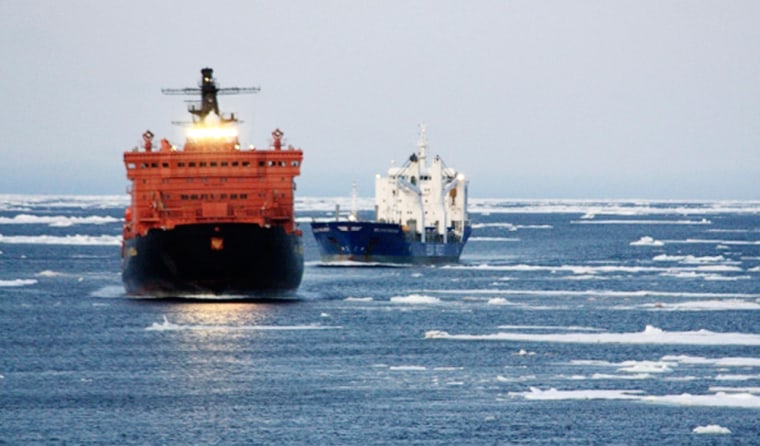Two German ships became the first commercial vessels to traverse the Arctic's Northeast Passage, their owner reported Friday, having arrived in Siberia from South Korea by traveling around Russia's northern coast line.
The merchant ships MV Beluga Fraternity and MV Beluga Foresight made it "through the formerly impenetrable Northeast Passage from Asia to Europe for the first time," Beluga Shipping GmbH said in a statement.
They traveled from Ulsan, South Korea, in late July to Yamburg, Siberia, by way of the route that until now had been avoided by commercial ships because of its heavy ice floes.
Scientists report that the Arctic Ocean ice cap has been shrinking to unprecedented levels in recent summers, because of global warming, opening many passages that were ice-choked in earlier times.
In July, new NASA satellite measurements showed that sea ice in the Arctic was not just shrinking in area, but thinning dramatically.
Niels Stolberg, the president of Beluga, which is based in Bremen, Germany, called it the first time a Western shipping company successfully transited the Northeast Passage.
He said the shipping company was planning more voyages through the area in coming months. Traditionally, shippers traveling from Asia to Europe have to go through the Gulf of Aden and through the Suez Canal into the Mediterranean Sea and, pending their destination, into the Atlantic Ocean.
A journey from South Korea to the Netherlands, for example, is about 12,700 miles. By going northward and using the Northeast Passage, approximately 3,500 miles and 10 days can be shaved off. That means lower fuel costs.
'Expression of climate change'
Researchers said the ability to navigate the route showed climate change.
"We are seeing an expression of climate change here," said Mark Serreze, director of the National Snow and Ice Data Center in Boulder, Colo. "The Arctic is warming; we're losing the sea ice cover. The more frequent opening of that Northeast Passage is part of the process we're seeing."
"The Arctic is becoming a blue ocean," Serreze told The Associated Press.
For the last few years, including this year, navigator Roald Amundsen's famous Northwest Passage has been navigable. Then in 2007, the more crucial deep water channel called McClure Strait opened up and now the Northeast Passage, Serreze said. The passage "is the traditional choke point," Serreze said.
That northern route "is going to become more and more open on a seasonal basis," Serreze said. But it won't be consistently open because of local weather patterns that could still freeze it up for long time periods.
This year is shaping up to have the third lowest amount of Arctic sea ice on record, just behind the worst year set in 2007 and in 2008. But just because 2009 is slightly up from the past two years, it is not an upward trend or a recovery, Serreze said. It reflects a change in local weather patterns that occurred in August, he said.
"It's certainly part of the overall decline of sea ice that we've been seeing," Serreze said.
Both German ships, which carried cargo for a power plant project in Surgut, Siberia, were escorted by a pair of Russian icebreakers during portions of their journey.
Russia has long used its northern coast for shipping fuel, supplies and other goods to its remote Arctic settlements, though funding for such shipments dwindled after the Soviet collapse.
